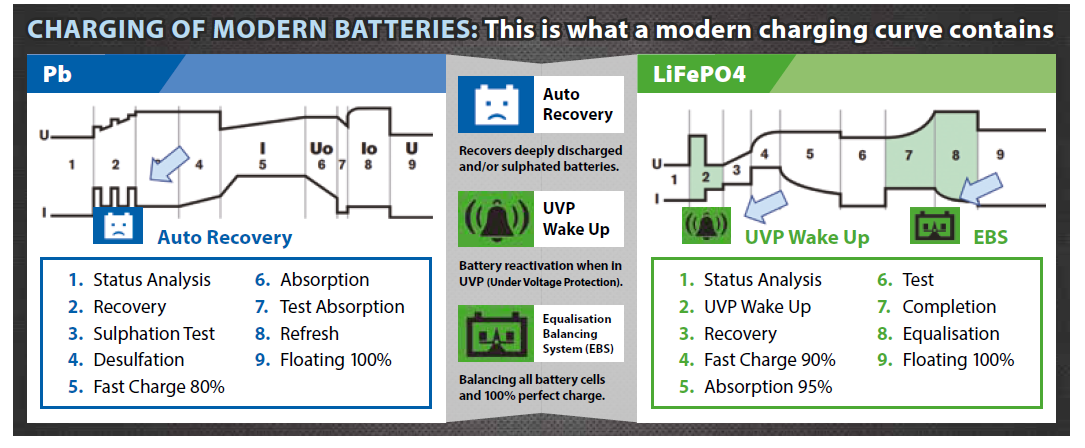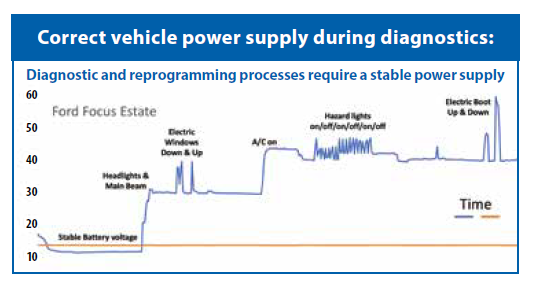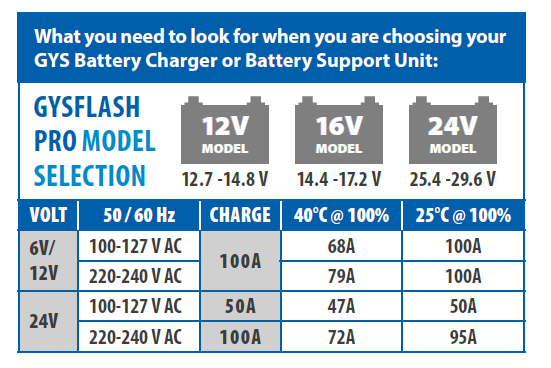
Tech Tips
The majority of batteries fitted to today’s vehicles are lead-acid, such as GEL, Absorbent Glass Mat (AGM), Sealed Lead Acid (SLA) or Enhanced Flooded Battery (EFB). Also utilised, but in smaller numbers at only around five percent of current usage, are Lithium batteries, primarily LifePo4, which require a charge that is perfectly monitored because they cannot withstand over-voltage.
It is essential for vehicle batteries to remain charged. This is especially true for AGM batteries fitted to a vehicle with a Stop-Start system, that they do not fall below 50% discharge, as anything below this will shorten its service life considerably.

Furthermore, a dedicated charging curve is essential for all types of batteries. For example, with AGM/EFB batteries, this curve will help avoid the capacity loss of the battery, increase service life, and speed up charging time. While for Lithium batteries, a dedicated charging curve will properly charge the battery, and assist in recovering the unit in case of Under Voltage protection.
It is important to remember that short journeys do not always provide a full recharge via the vehicle’s alternator and can even harm a battery if additional power is not supplied by a charger. Batteries also discharge when not in use, such as in showroom display or simply leaving the vehicle switched off with a door or tailgate ajar and not allowing the vehicle to properly shutdown.
This is where a Battery Support Unit (BSU) such as the GYSFLASH Pro range available from CoolDrive, is essential equipment for all workshops undertaking work that may affect a vehicle’s battery.
The high-powered GYSFLASH PRO BSUs are fitted with inverter technology and can maintain all battery types at a perfectly stabilised voltage, providing energy when the engine is turned off.
This is critical during the diagnostic phase, to identify any problems within the vehicle’s systems, and during the actual diagnostic work such as recalibrating ADAS sensors or reprogramming ECUs.
When any work is conducted on the bodywork or windscreen of a vehicle, the ADAS must be recalibrated to ensure the systems are operating correctly. This calibration of these ADAS sensors is incredibly energy intensive on the battery, as is the reprogramming of the ECU, or the Engine Control Unit.

As the engine is switched off during these diagnostics and reprogramming procedures - as well as during showroom display - this energy consumption should be compensated for, such as with a BSU. If not, side effects can include the complete and rapid discharge of the battery, unusable or damaged ECUs, incomplete or invalidated tests or reprogramming, and this vehicle may even have to be returned to the manufacturer.
All of this can affect the bottom line for the workshop when it comes to loss of time and money, not to mention customer dissatisfaction if the vehicle is returned to them with a damaged battery.
What to look for when choosing a Battery Charger / Battery Support Unit

Precise voltage selection is important. During diagnostics work, being able to set up different voltage is a must, simply because there is no standard voltage. If a wrong voltage is applied, the programming won’t be able to start.
When choosing a BSU, two parameters must also be considered – the max amperage (A) and the duty cycle, which is expressed in % and under a temperature (often 25⁰C & 40⁰C). If the max amperage is only taken into consideration, the diagnostic runs the risk of crashing. For example, if the BSU indicated 100A, but it can maintain only 50A at 25⁰C at 100%.
Being able to export data from the BSU and printing tickets as proof of the work undertaken is also another benefit to look out for. Not maintaining the voltage during diagnostic work can be harmful to the ECU, and in the event of damage, it is important to have proof that work was undertaken according to the vehicle manufacturer’s specification. Being able to print a ticket also shows physical evidence to the customer that the battery has been charged – and can be invoiced – or that the battery should be replaced.
Versatility and the ability to be upgraded are the final factors GYS recommends when choosing a BSU. The new kinds of batteries coming into the market, such as those utilised by Tesla (16V Li-on battery for the electronic board), can bring new challenges to the workshop. For example, how are these batteries charged, and how is diagnostic work performed on them? GYS has the solution with two new programmes available: 16 Li-ion – to charge these batteries, and 16V Diag+ to perform diagnostics.
The industry-leading GYSFLASH PRO BSUs, available in standard and CNT models, offer all these advanced functions and more, with outstanding reliable performance for all battery types from 6V to 48V.
Designed and manufactured in France, the GYSFLASH PRO units can be used both vertically and horizontally, with their onboard technologies making them highly configurable.


